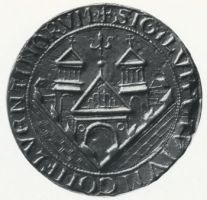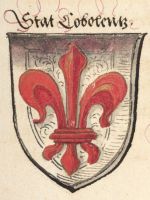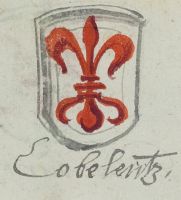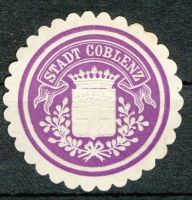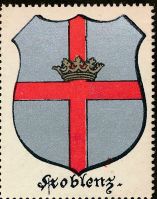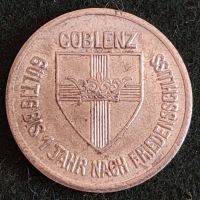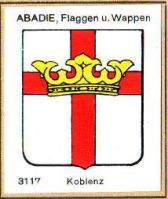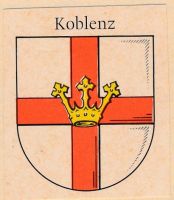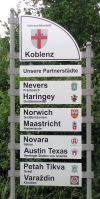Koblenz: Difference between revisions
Knorrepoes (talk | contribs) m (Text replacement - "{{media}}" to " {{de1}} {{media1}}") |
Knorrepoes (talk | contribs) m (Text replacement - "{{de}}" to "") |
||
| Line 1: | Line 1: | ||
'''KOBLENZ''' | '''KOBLENZ''' | ||
Revision as of 17:25, 26 December 2022
KOBLENZ
State : Rheinland-Pfalz
Urban District (Stadtkreis) : Koblenz
Additions : 1891 Neuendorf mit Lützel; 1902 Moselweiß; 1923 Wallersheim; 1937 Ehrenbreitstein, Horchheim, Metternich, Pfaffendorf; 1969 Güls, Kesselheim, Stolzenfels; 1970 Arenberg, Arzheim, Bubenheim, Immendorf, Lay, Rübenach
| German | In Silber ein durchgehendes rotes Balkenkreuz, belegt mit einer goldenen Krone mit drei langstieligen rautenkleeblättrigen Zinken. |
| English | No blazon/translation known. Please click here to send your (heraldic !) blazon or translation |
Origin/meaning
The first seals of Koblenz were mentioned in 1198, but the oldest existing seals date from the 13th century. All seals until 1282 show a city wall with a church and a lily (for St. Mary). In 1282 a rose appears on the seals. In the 13th century the arms changed into a fleur-de-lys, which evolved into a cross. The cross on the arms is derived from the arms of the State of Trier, to which the city belonged at the time.
The crown is described as a Crown of Mary, St. Mary being the patron saint of the city.
The only time the city used other arms was during the occupation under Napoleon. In 1810 arms were granted with in the lower half two wavy bends joining in the middle (for Confluentia, as in Koblenz the Mosel and Rhein rivers join). The upper half showed a silver diamond in a blue field, with a red cross and flowers on the diamond, which was flanked by two dolphins. And a chief with some grape vines. After the fall of Napoleon the old arms were restored.
The arms in a 16th century manuscript
with the fleur-de-lysThe arms in an album from around 1910
The arms in the Wappen-Sammlung (1900)
The arms by Hupp in the Kaffee Hag albums +/- 1925
The arms in the Abdulla album, 1928
The arms in the Abadie albums
The arms on a matchbox label
The arms in an album from 1968
The arms of Koblenz and its partner cities : Nevers, Haringey, Norwich, Maastricht, Novara, Austin, Petah Tikva and Varaždin
Literature: Stadler, 1964-1971, 8 volumes.

